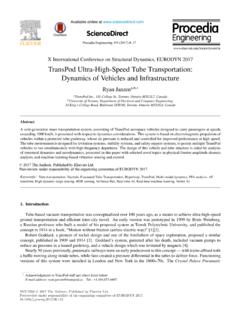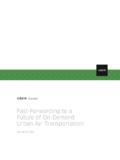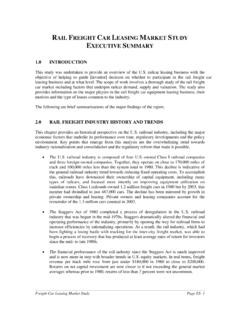Transcription of OECD OECD
1 OECD Studies in Risk ManagementNorwayTUNNEL SAFETYOECD Studies in Risk Management NorwayTUNNEL SAFETYL ooking back on the disasters of recent years alone (the Indian Ocean tsunami disaster, Hurricane Katrina, terrorist attacks in New York, Madrid and London, avian flu, the 2003 heat wave in Europe), one could be forgiven for thinking that we live in an increasingly dangerous world. A variety of forces are helping to shape the risks that affect us, from demographic evolutions to climate change, through the development of mega-cities and the rise of information technology. These changes are clearly a major challenge for risk management systems in OECD countries, which have occasionally proved unable to protect the life and welfare of citizens or the continuity of economic OECD Futures Project on Risk Management Policies was launched in 2003 in order to assist OECD countries in identifying the challenges of managing risks in the 21st century, and help them reflect on how best to address those challenges.
2 The focus is on the consistency of risk management policies and on their ability to deal with the challenges, present and future, created by systemic risks. The Project covers a range of risk management issues which were proposed by the participating countries and together form three thematic clusters: natural disasters, risks to critical infrastructures, and the protection of vulnerable population groups. In the first phase of the Project, the OECD Secretariat prepared a case study for each issue. The studies cover both recent international developments of interest and the national policy context, and come with a tool for self-assessment to be used later in the Project in order to review the national policies in question. This work is now published as the OECD Studies in Risk Management. w w w. o e c d . o rgOECDOECD OECD (2006)Applications for permission to reproduce or translate all or part of this book should be made to OECD Publications, 2, rue Andr -Pascal, 75775 Paris Cedex 16, France credits: REUTERS / JEAN-PAUL PELISSIER, GETTY IMAGES.
3 OECD STUDIES IN RISK MANAGEMENT ORGANISATION FOR ECONOMIC COOPERATION AND DEVELOPMENT Norway TUNNEL SAFETY 2 3 Foreword The OECD Futures Project on Risk Management Policies aims to assist OECD countries in identifying the challenges of managing risks in the 21st century, and contributing to their reflection on how best to address those challenges. Its focus is placed on the consistency of risk management policies and on their ability to deal with the challenges, present and future, created by systemic risks. It is designed in two phases. In Phase 1, the countries participating in the project propose specific themes as case studies of their risk management policies. For each proposal, the OECD Secretariat prepares an overview of the issue covering both recent international developments of interest and the national policy context. In addition, the Secretariat elaborates a tool for self-assessment and review, consisting of one or several questionnaires following the methodological framework of the project.
4 This prepares the ground for Phase 2 in which an in-depth review of the risk management issues will be conducted by a team of experts for those countries that wish it. Self-assessments will be used as the basis of these reviews. At the end of phase 2, a cross-country report will bring together the lessons learned from the project, and identify opportunities for sharing best practices and improving risk management. In the framework of the OECD Futures Project on Risk Management Policies, the Norwegian Ministry of Justice and the Police has proposed a Phase 1 case study on Risk management in connection with the prevention of and response to fires, and to accidents involving dangerous goods in underground traffic systems . The study would lay the ground for self-assessment and review of Norway s risk management policies concerning fires in tunnels, with the objective, in the Ministry s words, of identify[ing] and address[ing] current problems related to the balancing between risk (reduction) in the form of preventive, preparedness and response measures against fires and accidents involving dangerous goods on the one hand, and the desire to optimise the transportation of humans as well as goods in such traffic.
5 Tunnel safety has become a matter of concern and policy reform after a series of serious accidents in Europe, and although Norway has so far been spared from a large-scale accident, the number of tunnels in the country and its topographic specificities make tunnel risk management particularly challenging. This study has been prepared by Reza Lahidji and Marit Undseth, from the OECD International Futures Programme. The authors have benefited from the support of Hilde Bostr m Lindland and Terje Olav Austerheim, at the Norwegian Directorate for Civil Protection and Emergency Preparedness, and from the guidance of the Steering Group to the OECD Futures Project (list of members in Annex 6). The study is issued under the responsibility of the Secretary General of the OECD. 4 5 Table of contents Introduction .. 7 Safety issues in tunnels: lessons learned from recent accidents and 8 Selected developments in safety management.
6 16 International initiatives in road tunnel 16 International initiatives in rail tunnel 18 Country-level 20 The challenges of tunnel safety in Norway .. 22 The general 22 Risk and vulnerability 24 Evolutions in the safety management 27 Implications of international 29 The organisation of tunnel safety 30 Conclusion and proposal regarding the second phase of the 32 Bibliography .. 33 Annex 1. An overview of recent accidents and disasters in tunnels and underground transport 39 Annex 2. Risk-based methodologies for the management of tunnel 43 Annex 3. The policy context in 49 Annex 4: Legal and regulatory 55 Annex 5: Self-assessment and review questionnaires .. 57 Annex 6: Members of the Steering 71 6 7 Introduction In the framework of the OECD Futures Project on Risk Management Policies, the Norwegian Ministry of Justice and the Police has proposed a Phase 1 case study on large-scale accidents in underground traffic systems.
7 The issue of tunnel safety is of particular importance to Norway due to the country s topography and the specificities of its road and railway networks, not least in light of the implications for Norway of the adoption of a new European Directive on minimum safety requirements for road tunnels. The aim of the case study is to prepare the ground for self-assessment and a review of the policy framework applied to tunnel safety. Policy decision-making regarding tunnels has to take account of a myriad of factors, including risks, technical solutions, human, societal and economic costs and benefits, trade-offs and linkages between prevention and preparedness, consideration of alternative means of transport and routes, and the standpoints of the various stakeholders. It also involves a range of national and local actors, and is implemented in part through a set of laws and regulations.
8 The review of tunnel safety policies will have to consider the way and extent to which all these elements are integrated in the decision-making process; the institutional setting, in particular the sharing of roles and responsibilities between the various centres of decision-making; and the consistency of the legal and regulatory framework. This Phase 1 study provides a general overview of recent developments in road and railway tunnel accidents and safety, analyses the Norwegian context against this background and elaborates a tool for self-assessment and review in the second phase of the Project. The first part of the study reviews the lessons learnt from some important accidents that have occurred in tunnels and other underground transport systems in recent years. Safety management at the international level is analysed in the second part, and the third part examines the Norwegian situation and policy context, and the major challenges the country faces in the field of tunnel safety.
9 Annexes 1 and 2 complement the study with a more thorough presentation of recent accidents (annex 1) and risk-based methodology for tunnel safety (annex 2). Annexes 3 and 4 describe the relevant safety management authorities and regulations following the project s methodological framework. Annex 5 proposes the main lines of five questionnaires, designed as a tool for self-assessment and review. 8 Safety issues in tunnels: lessons learned from recent accidents and disasters The risks related to road and rail tunnels and underground traffic systems have been tragically illustrated by a succession of large-scale accidents, or sometimes even disasters, in the past years: the King s Cross underground station fire in London (1987), the successive fire disasters in the Mont Blanc (March 1999), the Tauern (May 1999), and the Saint Gotthard (October 2001) tunnels, and most recently the deliberately caused or triggered disasters of Daegu (February 2003), Madrid (March 2004) and London (July 2005).
10 1 Notwithstanding their specific causes and circumstances (which, in certain cases, are still to be determined), such events shed light on a number of key facts regarding tunnel safety, which are developed hereafter: (1) the risks related to road tunnels belong to the low probability/large consequence type; (2) inadequate tunnel structures, freight vehicles and safety procedures remain important factors of vulnerability; (3) railway tunnels are relatively safer, but the market share of rail in total freight has been steadily decreasing; (4) human responses to emergency situations are of utmost importance in tunnel safety; and (5) malevolent acts have to be factored in safety design and management. (1) Transport through road tunnels entails risks which can be characterised by a low probability of occurrence and potentially catastrophic consequences. The main threats to safety inside tunnels are fire, smoke, spillage of hazardous substances, and explosions, which can be caused by accidents, defects in the tunnel structure or in vehicles, human error.















